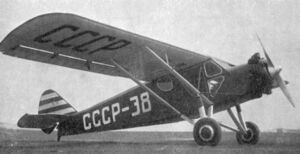Engineering:Yakovlev AIR-5
From HandWiki
Short description: Prototype Soviet single-engined cabin monoplane
| AIR-5 | |
|---|---|

| |
| Role | Single-engined cabin monoplane |
| National origin | Soviet Union |
| Manufacturer | Yakovlev |
| First flight | 1931 |
| Number built | 1 |
| Developed into | Yakovlev AIR-6 |
The Yakovlev AIR-5 was a prototype Soviet single-engined cabin monoplane designed by the Yakovlev design bureau.[1] The AIR-5 was a high-wing strut-braced monoplane with a 200 hp (149 kW) Wright J-4 Whirlwind engine.[1] It had a tubular steel fuselage, wooden wings and an enclosed cabin for a pilot and three passengers.[2]
When the Whirlwind engine became unavailable no further aircraft were produced and a smaller variant was designed with a locally produced M-11 radial engine and designated the AIR-6.[2]
Specifications
Data from The History of Soviet Aircraft from 1918[3]
General characteristics
- Crew: one
- Capacity: three
- Length: 8 m (26 ft 3 in)
- Wingspan: 12.8 m (42 ft 0 in)
- Height: 2.46 m (8 ft 1 in) (tail up)[4]
- Wing area: 23 m2 (250 sq ft)
- Empty weight: 670 kg (1,477 lb)
- Max takeoff weight: 912 kg (2,011 lb)
- Powerplant: 1 × Wright J-4 Whirlwind air-cooled radial engine, 150 kW (200 hp)
Performance
- Maximum speed: 192 km/h (119 mph, 104 kn)
- Cruise speed: 152 km/h (94 mph, 82 kn) [4]
- Range: 1,000 km (620 mi, 540 nmi) [4]
- Service ceiling: 4,275 m (14,026 ft)
- Time to altitude: 6.5 minutes to 1,000 m (3,300 ft)[4]
References
Notes
Bibliography
- Gordon, Yefim; Komissarov, Dmitry; Komissarov, Sergey (2005). OKB Yakovlev: A History of the Design Bureau and its Aircraft. Hinkley, UK: Midland Publishing. ISBN 1-85780-203-9.
- Nemecek, Vaclav (1986). The History of Soviet Aircraft from 1918. London: Willow Books. ISBN 0-00-218033-2.
- The Illustrated Encyclopedia of Aircraft (Part Work 1982–1985). Orbis Publishing.
 |

